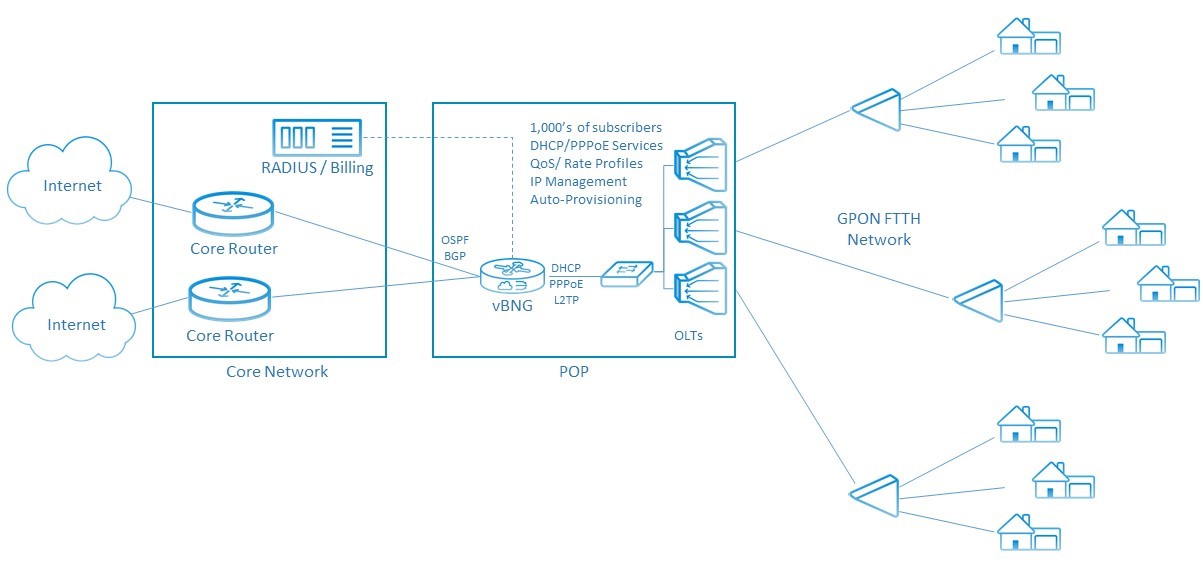Solutions for Rural Broadband Providers
Innovative Access Services and Routing
Even in the face of economic and political challenges, rural broadband providers are driving the deployment of higher internet speeds and the adoption of broadband services in rural communities. Rural providers deliver essential, high-speed broadband services to residents and virtually all major institutions in their communities, including schools, hospitals, and public libraries. In addition, they are rapidly replacing old copper networks with fiber.
netElastic virtual Broadband Network Gateway (vBNG) is built to help rural providers easily and economically build high-speed networks, whether it’s a fiber buildout or increasing network scalability with minimal infrastructure investments.
Automate Subscriber Provisioning and Management
Broadband Network Gateway routers (BNG or BRAS) are the critical routing infrastructure used to enable network and subscriber management automation. Deploying a BNG in the network eliminates manual subscriber provisioning while adding automation and integration into service provider billing and other operational systems.
vBNG includes DHCP, PPPoE services, and IP address management. vBNG also interfaces with your billing system via RADIUS to authenticate subscribers, set their appropriate service and rate profile, and provide the accounting records back to your billing system.
This automation reduces theft of service, rate and service plan inconsistencies, and manual provisioning errors which can lead to a poor customer experience.
BENEFITS

Software Flexibility
netElastic virtual BNG is a full-featured broadband network gateway (sometimes called a broadband remote access server) that runs on x86 servers. This approach allows network operators to select the scale and deployment design that best fits their network, whether it’s a large centralized platform or a set of smaller decentralized BNGs deployed close to the customer edge. And since it runs on standard off-the-shelf hardware and works with all OLT and DSLAM equipment, there is no hardware vendor lock-in.
Performance and Scalability
netElastic vBNG delivers up to 1 Terabit of throughput on a 2RU server. The same vBNG software can start as small as 2 x 10 Gbps for less demanding use cases and scale up as demand (and revenue) grows.
Carrier Grade NAT (CGNAT) and IPv6 Transition
Service providers in many countries can’t get sufficient IPv4 address space and may have to add expensive extra CGNAT cards or appliances. netElastic’s software-based CGNAT is built on our high-performance virtual router technology, a very scalable software architecture that delivers high translation performance while supporting a broad range of additional routing capabilities. netElastic CGNAT also supports detailed session logging that is compatible with many government regulations.
For service providers transitioning to IPv6, vBNG supports Dual Stack and full IPv6 support. CGNAT for IPv4 and Dual Stack IPv4/v6 allows network operators to deliver the services needed today while preparing for the IPv6 network of the future.
Reduce Wasteful Spending
Government funding is crucial to supporting broadband expansion into underserved and rural markets. This funding comes with the expectation that capital will be used efficiently, with no wasteful spending. As the Broadband Equity, Access, and Deployment (BEAD) program and other programs expand, there is increased scrutiny on how these investments are used, and future funding will be directed toward operators that demonstrate efficiency.
Given the emphasis on network and cost efficiency, vBNG from netElastic helps rural providers modernize their networks while saving up to 70% over traditional hardware vendor solutions. These cost savings can be used to deliver services to more homes. And as competition for funding increases, providers connecting more homes at less cost will be the winners.
The Advanced Features You Need
netElastic vBNG provides all the features required to manage subscriber access without paying for unnecessary features. IPoE/DHCP and PPPoE services, ACL, QoS, rate profiles, and IP address management are all included. RADIUS AAA (with COA) allows integration with billing and automation, and BGP, OSPF, and ISIS routing protocols support core network requirements. MPLS features, including subscriber to VRF mapping, support business broadband for enterprise clients.

